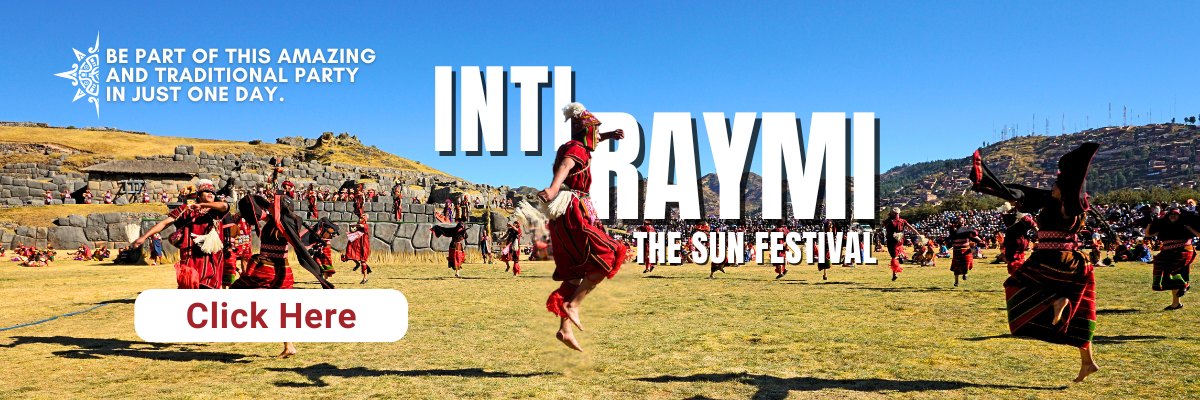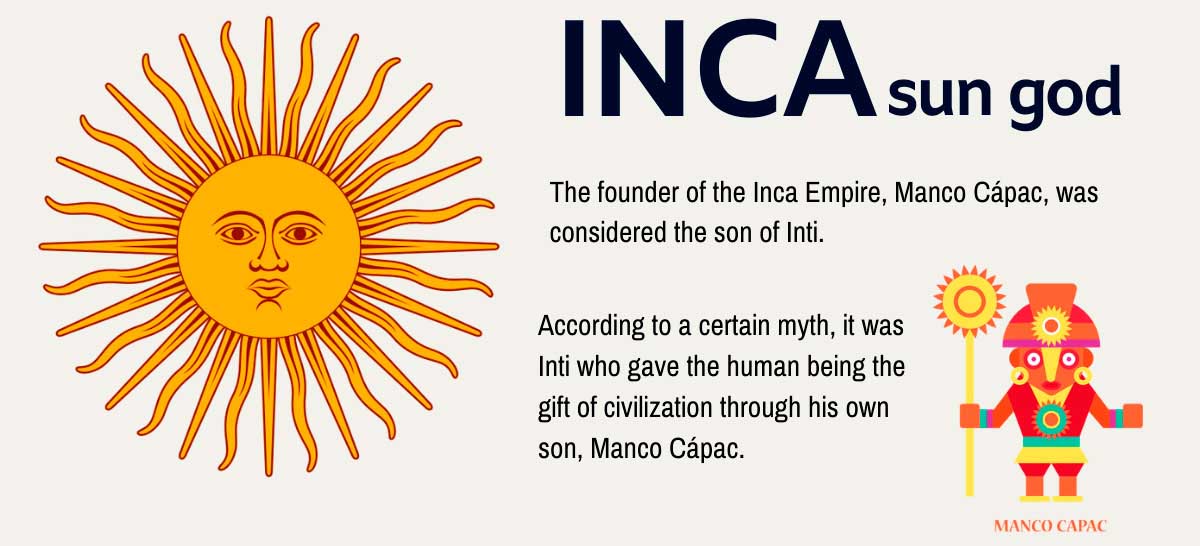The Inca gods and their attributes are recognized by the representation of the natural and cosmic environment that made up the religious pantheon of the ancient Inca empire, a South American civilization located in the Andes Mountains.
This civilization was made up of a very religious population. The Inca mythology were totally intertwined in everyday life. Everything the Incas did had religious significance.
The most outstanding cultural features of Inca mythology focused on the description and worship of the natural world that surrounded them, where each aspect and element was animated by powerful spirits and ancestors that transcended the sacred plane.
The Inca gods lived in both heaven and earth and each of them had specific functions that influenced every aspect of Inca life. The hierarchy in your pantheon was determined by the importance of each purpose.
Many of Inca gods were inanimate objects or elements of nature, such as mountains, rivers, plants, rain, lightning, and of course the sun and the moon.
They also honored deities shaped like animals such as monkeys, jaguars, and condors. The Incas believed that their gods had patterns of human behavior, especially anthropomorphic ones; they were able to feel love, hate, compassion and more human emotions.
During their years of conquest, the Incas integrated towns close to the territories of their great empire. This made Inca society come into contact with diverse religious beliefs that were amalgamated within their own customs.
Like many of the mythologies of ancient civilizations, the Inca mythology put special importance in the stories about the creation of the world and of man. These stories, which included the majesty of sacred places like Machu Picchu, were passed down orally from generation to generation, as none of the Andean civilizations developed a writing system.
The Conformation of the World
The Inca Trilogy (Andean Trilogy) in the Inca religion. They represent the heavens (Hanan Pacha) where the gods reside, the earth or world of the living (Kay Pacha) where we humans inhabit, and the underworld (Uku Pacha) or the world of the dead:
Hanan Pacha translates to the heavens. It was represented by a condor. The condor was sacred to the Incas. They believed that it communicated the upper world (Hanan Pacha) with the earthly world (Kay Pacha).
Kay Pacha translates to ‘the world of living. It is represented by a puma. It symbolizes strength, courage, freedom, and intelligence.
Ukupacha translates to the underworld. It was represented by a serpent or Ssnake. it inhabits underground at the bottom of lakes and rivers and in caves.The serpent symbolizes the world below(the Ukhu Pacha). It represented wisdom
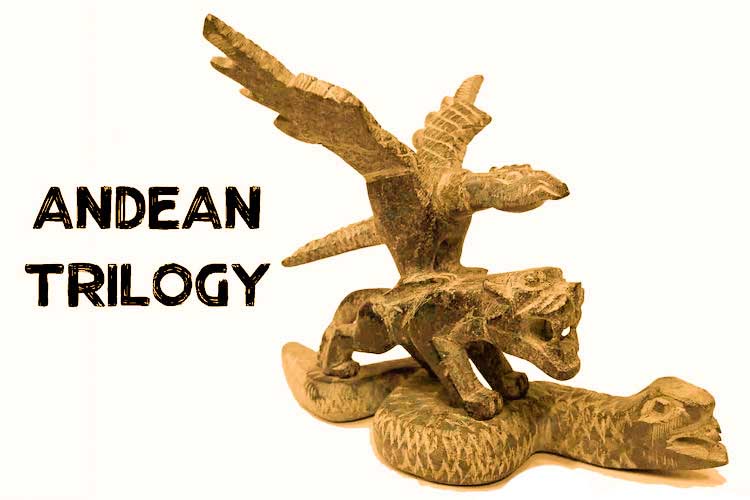
The Formation of Sacred places: Hills and Lagoons
Throughout the Inca culture, a kind of pilgrimage tradition occurred. The organizing centers of the Andean space were sacred symbols, places where people gathered to worship their gods, accepting the dominance of the representatives of the supernatural powers on earth. Huiracocha created lakes and lagoons, it was an inexhaustible source of life.
The apus were considered male divinities. These were worshiped, from the smallest domestic units, to the highest elites of Inca society, and other kingdoms and lordships.
The arrival of the Spanish came with the imposition of the western religion, which they made theirs, mixing them with their ancestral customs, so that they were visibly acceptable to the invaders of the west.
What are the Inca gods?
The Main Inca gods are:
Viracocha
A god previous to the Inca world because it was known from time immemorial. Possibly it would be a deity belonging to the Peruvian nomadic peoples who inhabited the Andean area, hence, since its birth, it was moving through various areas.
Also known as Wiracocha, he is the creator god, the essence of the origin and he is considered the first divinity par excellence of the Peruvians, regarding his cult we can say that initially he was exclusively destined for the nobility. It is said to have arisen from the waters and subsequently created heaven and earth.
It seems that he arises in the waters and after a long journey he decided to create heaven and earth, therefore, he is the god of creation. On his travels he was accompanied by Inti, a magical bird who knew what had happened and what would happen. For this reason, the Inca emperors adorned their crowns with large feathers to simulate that they belonged to Inti, which provided them with the knowledge necessary to reign.
This Inca god is represented with a stick in each hand as lances.
Inti
In addition to being Viraocha's traveling companion, he was the Sun god. The offerings he received were large, especially being gold / silver, youth and animals, and his temples were all over the confines of the Inca empire.
The sun god, relieved, brought forth crops and provided security for humans.
Said deity is represented with a golden disc and human features.
The Inca ruler offered up animal sacrifices to the sun god on 21 June to celebratre the sun worship festivity (Inti Raymi)
Pacha Mama
It is the sustenance of all nature and therefore it is called mother earth.
Goddess of the earth, the cult for the fertility of the crops was carried out to her, therefore, the offerings had to be large, because otherwise she could make the crops not important enough.
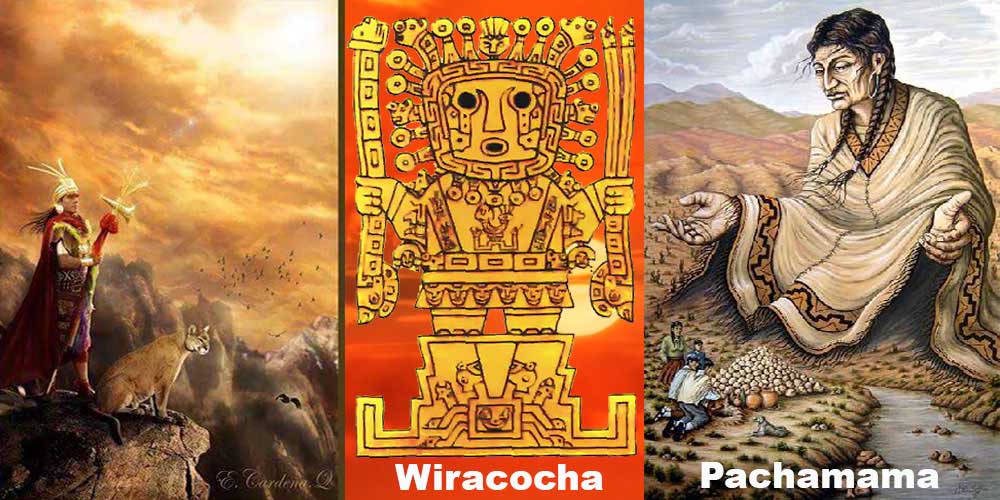
Pachacamac
Although it corresponds to an edition of Viracocha, he is known as the god of tremors. He was also considered the creator of the world, therefore, he is usually associated with Viracocha. An unscrupulous god is how he is represented in his mythology, even going so far as to kill one of his sons and his own wife, he would be dethroned by Wichama, another of his sons, who, thanks to his cunning, could deceive his father and thus finish him off.
We know that Pachacamac's wife was killed by her husband and sent to the earth cut into small pieces, which fertilized the earth.
Mama Cocha
Goddess of the sea, fishermen were entrusted to her so that the waters remained calm, in addition to being able to fish in abundance. Represented everything feminine, it was also who calmed the waters and helped good fishing.
She was also highly revered by women, as she was the goddess of everything related to the female world.
Venerated especially by fishermen to calm the waters and obtain the benefits of abundant fishing.
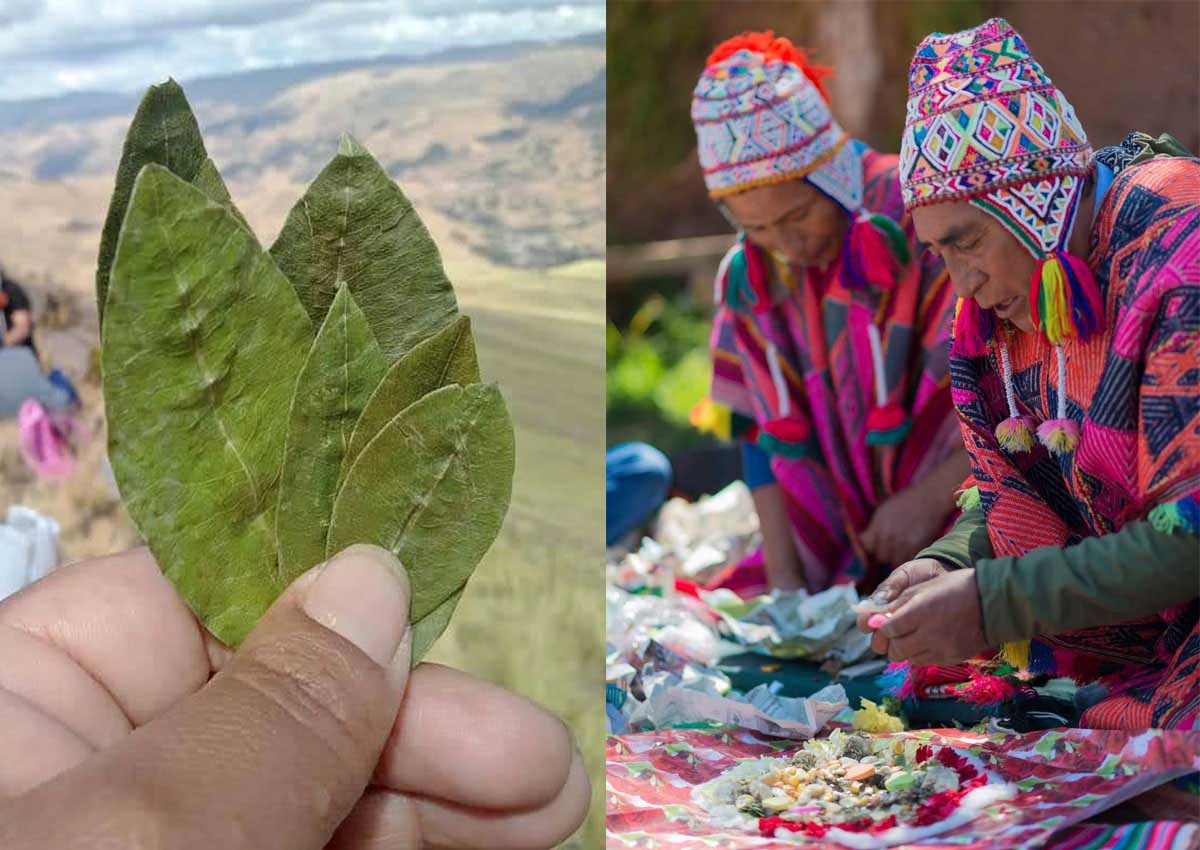
Mama Coca
Goddess of health and happiness, according to the legend it was split in two and one of its parts, would originate the coca plant, highly consumed by the Andean people, according to their mentality, these plants gave health and happiness.
At first she was considered a promiscuous goddess. Her lovers divided it into two parts. His body was transformed into the first coca plant.
Men who chewed coca were not allowed to touch their children if they did not previously sexually satisfy their wives.
The ancients believed that the coca plant provided health and happiness.
Supay
The god of the dead, as well as being the evil spirits of the underworld. Currently, the devil is known by that name in the indigenous areas of Peru or Bolivia.
Mama Quilla
Goddess of the moon, mother of the firmament. He especially protected women and therefore they were the ones who worshiped him the most.
Mama Quilla was the mother and wife of the god Inti. In the temple of the sun there was a statue dedicated to his worship.
Mama Sara
It is the goddess of corn and food. Corn, along with coca and potatoes were essential foods of the Incas.
lllapa
Illapa was the god of climate and one of the most popular gods.
Its name means lightning and thunder. It was believed to make it rain from the Milky Way with water that it kept in a jug.
In times of drought, the Incas used to tie black dogs until they suffered hunger so that the god Ilyap´a took pity on them and sent the rain.
Coyllur
The goddess of the stars.
Wasikamayuq
God of home.
Supay
Maleficent spirits who spoke Quechua were called Supay.
Supay was also the god of the dead and owner and lord of the underworld.
Today, the Catholic aborigines of Peru and Bolivia call the devil Supay.
Apus
He was the god or great spirit of the mountains. It was believed that all the important mountains for the Inca people had their own Apu, as well as some rocks and caves. These Apu were offered sacrifices to obtain the strong aspects of being.
The Apus were protectors of the territories; As imposing guardians above all Inca lands, they cared for the people, the cattle, and the crops.
Apus
Since pre-Inca times, the Apus have been considered as living or spiritual mountains in various towns in the Andes, which are attributed a great divine influence to provide help and protection to the inhabitants of the place.
Although the Inca empire disappeared hundreds of years ago, today there are still peoples that preserve this tradition and continue to worship these Inca gods.
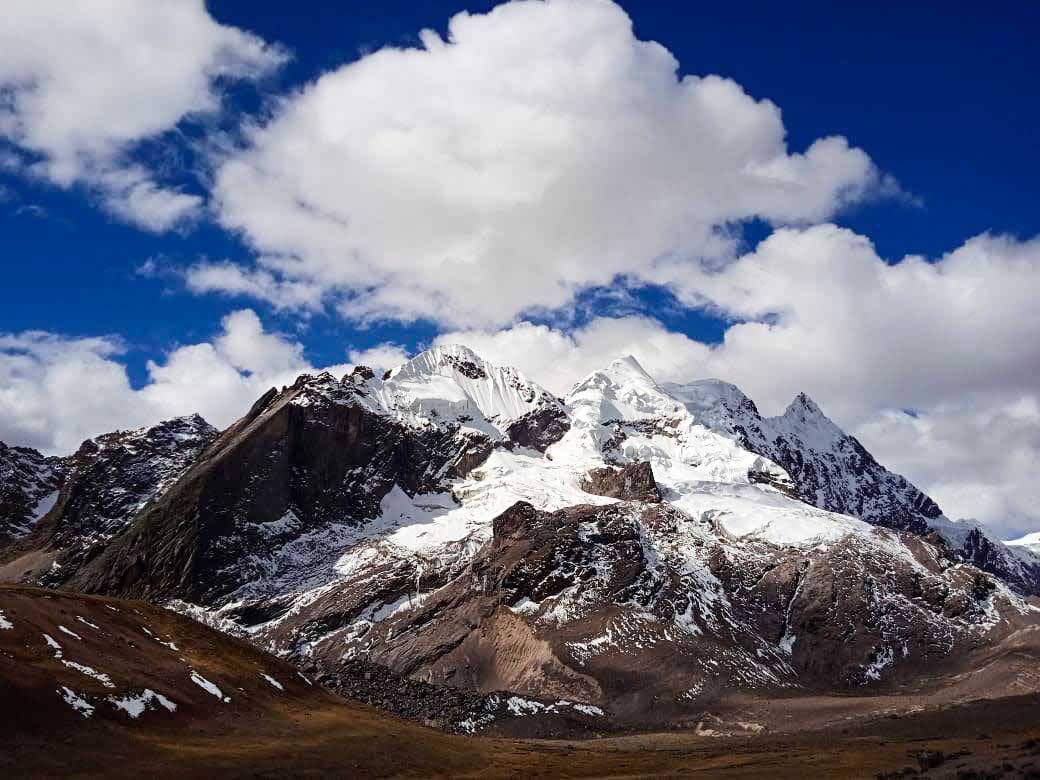
Importance of the Apus gods
They were known as the spirits of the mountains or the living mountains, which did not communicate with humans, but attended to the requests they made through sacrifices and rituals.
The Apus in quechua were of great importance in the spiritual world, since they were considered as those in charge of providing relief and sustenance to those who requested it with their faith.
The highest mountains, such as the majestic Salkantay, when raised to the heavens were considered to favor the communication of humans with the Inca gods. The Incas, through rituals and sacrifices, managed to please the Apus in quechua and obtain protection for their people, lands, cattle and crops in return.
Cults to the gods Apus
The cults, offerings, rituals, prayers, and sacrifices to the Inca gods were fervently performed to request divine protection for years to come. These cults included food offerings, dances, coca leaves, corn liquor and on special occasions human sacrifices known as Capac Cocha were carried out.
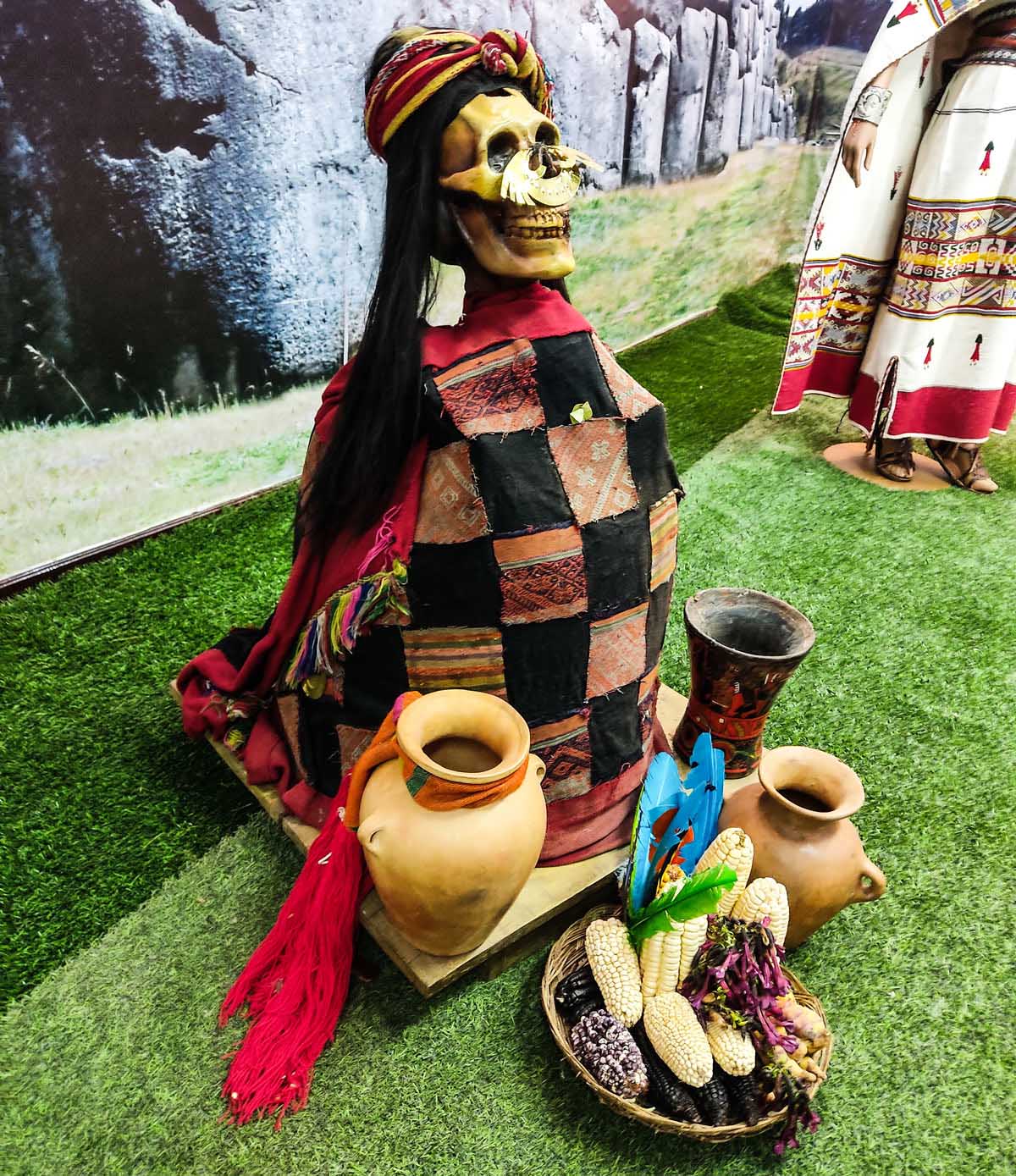
Among the human sacrifices to which the Incas resorted are the following:
- The Juanita Mummy.
- The Ice Maiden.
- Lady of Ampato.
The Most Important Apus in Quechua
The mountains with the highest altitude were considered the most powerful and sacred, among which the following Andean summits stand out:
In Peru:
- Ausangate, 6372 masl.
- Chachani, 6075 masl.
- Ampato, 6310 masl.
- Coropuna, 6425 masl.
- Sara Sara, 5505 masl.
Cusco´s Apus
- Senca
- Mama Simona
- Wanakawri
- Ausangate
- Pachatusan
Machu Picchu´s Apus
- Salkantay
- Piscachani
- Yananti
- Putucusi
- Veronica
Choquequirao´s Apus
- Qorihuayrachina
- Padreyoc
- Choquetacarpo
In Argentina and Chile:
- Esmeralda, 950 masl.
- Licancabur, 5921 masl.
- Quehuar, 6130 masl.
- Chuscha, 5512 masl.
- El Toro, 6380 masl.
- Aconcagua, 6960 masl.


